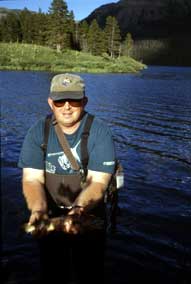Colorado Cutthroats
by Al Marlowe
Most anglers know that Colorado's native trout is the cutthroat. How many know which subspecies call our state home?
Colorado has three subspecies – Colorado River, greenback, and Rio Grande. A century ago there were four. The latter was the yellowfin, extinct early in the 20th Century. Non-native cutts along with hybrids are also found in the state's streams and high lakes. Where do we begin to sort all this out?
In the mid-1800s cutthroats were the only trout in Colorado. Development that still causes problems for wild cutthroats, along with other wildlife, had it's beginnings with the discovery of gold. Habitat destruction from mining practices of the period, along with over harvesting by emigrants to the state brought about a sharp decline in cutthroat populations.
Along with the three native cutthroats in Colorado, the state has stocked Snake River and Pikes Peak cutts. Snake River cutthroats are stocked in places like Spinney Mountain, Antero, and Wolford Mountain Reservoirs because of their hardiness and rapid growth rates. They have also been stocked in high lakes in the Weminuche Wilderness Area in the San Juan Mountains. The Pikes Peak variety, a hybrid, is stocked in suitable lakes along the Front Range. Both of these species provide fish for the creel as well as sport.
 |
| Angling for Colorado Cutthroats can be rewarding |
Colorado River Cutthroat: Oncorhynchus clarki pleuriticus
Colorado River cutthroat were once abundant in Grand Lake, source of the Colorado River. They were seined from the lake in large numbers, providing food for area settlers, and, according to accounts in the 1870s, specimens of up to 20 pounds were taken; they were also found in abundance in Trappers Lake, which has been called "the Yellowstone Lake of Colorado" because of its value as a cutthroat trout fishery and its longstanding use as a source of spawn for stocking of other waters across the state. These cutthroats still retain traits of Colorado River cutthroat, but the genetic purity of the entire stock has now been brought into question by a succession of both authorized and unauthorized plantings of rainbow trout and nonnative strains of cutthroat trout.
Presently, all populations of Colorado River cutthroat trout are found in habitats over 7,000 feet elevation, and in Wyoming above 8,000 feet. Historically, the Colorado River cutthroat's range included portions of large rivers, such as the Green, Yampa, White, Colorado, and San Juan. Additionally, lower reaches of these large rivers are believed to have been suitable for migration during winter when water temperatures are lower.
Greenback Cutthroat: Oncorhynchus clarki stomias
According to researchers at Colorado State University greenbacks are the most easterly of all cutthroats, evolving over two million years from Pacific salmon, steelhead, and coastal cutthroats, that migrated up the Columbia/Snake River system to Yellowstone and the Green/Colorado River system. Sometime during the most recent Ice Age (10-20,000 years ago) these ancestral fish somehow managed to cross over the Continental Divide and evolved in isolation thereafter to become a distinct subspecies.
The greenback is federally listed as threatened but may soon be recovered to the point where it can be removed from the list. The native trout of Colorado's Front Range, was believed extinct by the 1930s. Today, the greenback again lives wild and free in 40 remote streams and lakes in its historic range.
Saving the greenback wasn't just a matter of rearing a few fish in a hatchery and turning them loose. As with all cutthroat trout, greenbacks don't take survival seriously. They show no reluctance to take a fly if it's presented with a minimum of carelessness. Greenbacks willingly interbreed with other cutthroat species and rainbow trout. When competing species, like brook or brown trout, invade their territory, the cutthroat defers, allowing other fish to dominate their home.
When over harvest and habitat degradation led to declining numbers of cutthroats, the Leadville National Fish Hatchery was established in 1889. It was, however, unable to rear greenbacks using 19th Century technology. Other species, more easily adapted to an artificial environment were raised and stocked to replace the greenback, further contributing to their decline.
The restoration of the greenbacks was a joint effort involving USFWS, U.S. Forest Service, National Park Service, Bureau of Land Management, CDOW, Colorado State University, the U.S. Army, and Trout Unlimited, along with donations from corporations, and volunteer labor provided by TU members. After determining the fish's original range, suitable locations for re-introductions were selected on land controlled by NPS, USFS, and BLM. The locations were treated to remove competing brook and rainbow trout.
"Problems with raising greenbacks in a hatchery environment had to be overcome," USFWS biologist Bruce Rosenlund said. The problem was to get the females ready to mate when males were in the mood and vice-versa. Controlling water temperature and light turned out to be the key to solving that problem.
The greenback is still listed as threatened. Fishing is restricted to only a few locations listed in the CDOW regulations and property directory. Where fishing is allowed, all greenbacks caught must be released.
Rio Grande Cutthroat
The Rio Grande cutthroat trout once ranged over much of the upper Rio Grande basin in New Mexico and southern Colorado, according to Craig Springer, fisheries biologist for USFWS in Santa Fe. Competition with non-native trout, coupled with habitat loss, now limits the imperiled native trout to less than 10 percent of its original range. But its range is growing, thanks in part to a multi-agency partnership in both states, Springer said.
The Forbes Trincheria Ranch in the San Luis Valley has been a refuge for Rio Grande cutthroats and has cooperated with Division conservation efforts for 25 years, according to Assistant Ranch Manager Alfred Pacheco. "Other cutthroat streams on the ranch have been invaded by brook trout," Colorado Division of Wildlife biologist John Alves said. If the work on West Indian Creek is successful, he will take similar action on those creeks. Removal of brook trout, followed by periodic control, from a stream that is historic habitat for pure Rio Grande cutthroat trout may help to upgrade the stream's native fish population's status from declining to stable.
With 65 currently known Rio Grande native waters in Colorado, 22 are secure and stable or expanding, 16 are stable but at risk, 21 are at risk of declining, the status of six populations is unknown. "Twenty-six streams on private land have Rio Grande cutthroat populations, which are important to the subspecies' protection because they control over-harvest and land-use impacts," Alves said.
 |
| A nice cutt caught at Trappers Lake |
Outlook For Cutts
Colorado's wilderness areas are the primary locations for anglers to fish for cutthroats. There are enough waters holding less-than-pure strains to continue to permit fishermen to enjoy a meal on a backcountry outing. Don't pass up the opportunity to cast a fly in the many tiny creeks in remote areas. These often hold wild cutthroats willing to smack a Humpy or Elk-hair Caddis. Be aware, though, that being wild, these fish need a careful presentation. Keep a low profile when near a stream bank.
The good news for anglers is that we have cutthroats to catch in Colorado. Even though survival of pure strains of the three threatened species isn't yet assured the future looks bright.
 |
| Trying his luck for cutthroats |



